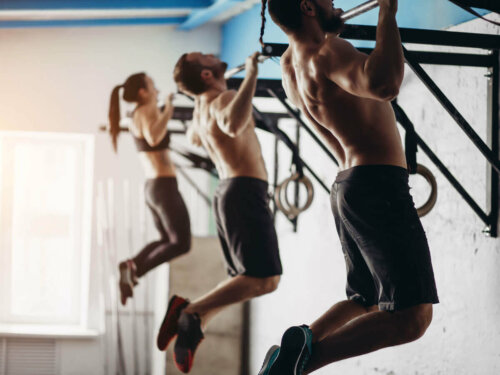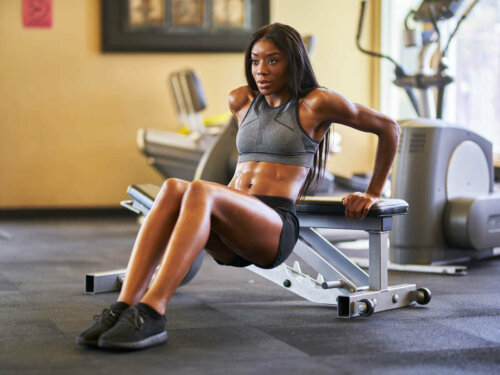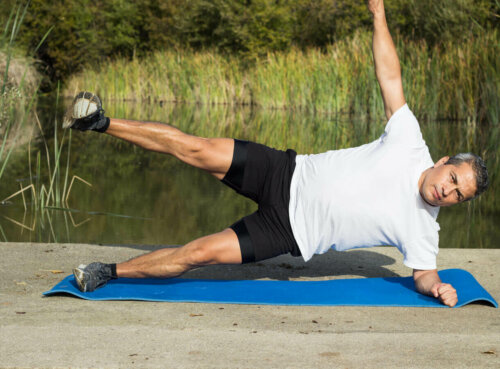Four Upper Body Exercises for Running

No, we’re not misleading you! In this article, we’re going to talk about upper body exercises for running, not lower body ones. But why? Although training the upper body for running seems illogical to many people, the torso and its relative extremities are also important. Find out how they can help you!
Below, we’ll explain some important reasons why you should consider this training, as well as a series of recommended exercises to include in your upper body routines.
Upper body exercises for running?
Most runners tend to emphasize lower body training, neglecting their core, back, and arms. In the long run, this can cause a significant imbalance in the body, leading to poor running performance. In fact, it can even lead to several injuries.
Thus, it’s essential to train your upper body for running. However, we need to differentiate the type of training that you must do. To practice speed sports such as track and field, you don’t need to have hypertrophied arms.
In fact, it’s best to tone them and achieve the appropriate mass to enhance strength. In addition, your torso muscles must be in excellent condition to avoid imbalances and poor technique.
Upper body exercises for running offer the following benefits:
- Strengthening your core, which allows to you exert more force with your lower extremities.
- More toned and slimmer arms for momentum during running.
- Lower probability of imbalances and injuries.
- Greater protection for joint areas, which receive impacts while you’re running.
- Lower energy expenditure when executing technical movements.
Upper body exercises for running
Due to what we explained above, it’s essential to have a series of exercises to train before running. To help you add them to your routine (we recommend also consulting your trainer), we’ll present a series of alternatives. Take note and do them!
Superman
This exercise strengthens your core area, especially your back, which is essential when running. To do it, adopt the prone position, with your arms and legs extended.

Then, symmetrically elevate both limbs, contracting your back muscles. After you finish, return to the starting position. It’s important to always look forward when you do the exercise.
Bars or barbells
A good alternative to strengthen your upper limbs, shoulders and part of your torso are traditional bar exercises. Commonly called “chin-ups”, you can do them in any setting.

You have to hold the bar with your hands facing your body, at shoulder-width. Once you position yourself, elevate your body until your chin exceeds the height of the bar, tensing both arms at all times. Subsequently, slowly lower your body.
Dip bar leg raise
Toning the back of the arms is usually a somewhat complex task. But dip exercises can help you reach your goal. For greater benefits, elevating your legs on another bench increases the complexity of this exercise.

Support both hands on a bench of approximately 15 inches. After that, support your legs on another bench of a similar height. Then, flex your arms to a 90-degree angle, bringing your glutes as low as possible. Finally, return to the starting position.
Side plank with leg raise
As the core is very important while running, it’s advisable to do exercises that help strengthen it. Undoubtedly, planks are one of them.
To do this exercise, you must support your body on your forearm and the outside of the foot. Also, your back, head, and legs must be aligned.

To do a plank, you have to abduct and adduct (elevate) your upper leg. After you complete the set, repeat with your other leg.
Execution of the exercises
As experts always recommend, each person must adapt the exercises according to their routine. However, in general, you can take the following parameters into account:
- Do three sets of each exercise.
- Rest between 60 and 90 seconds between sets.
- Do 12 to 15 repetitions.
- Don’t forget the warm-up and cool-down phase, before and after your routine, respectively.
Train your upper body and not just your legs for running
Your body works as a whole. Although some sports practices, such as running, require greater lower limb effort, you shouldn’t neglect the rest of your body. In addition, these exercises require adequate asymmetry between your arms and legs to better execute each movement.
For this reason, exercise routines for runners must ensure upper and lower body cohesion. Incorporate them into your routine to become a better runner!
No, we’re not misleading you! In this article, we’re going to talk about upper body exercises for running, not lower body ones. But why? Although training the upper body for running seems illogical to many people, the torso and its relative extremities are also important. Find out how they can help you!
Below, we’ll explain some important reasons why you should consider this training, as well as a series of recommended exercises to include in your upper body routines.
Upper body exercises for running?
Most runners tend to emphasize lower body training, neglecting their core, back, and arms. In the long run, this can cause a significant imbalance in the body, leading to poor running performance. In fact, it can even lead to several injuries.
Thus, it’s essential to train your upper body for running. However, we need to differentiate the type of training that you must do. To practice speed sports such as track and field, you don’t need to have hypertrophied arms.
In fact, it’s best to tone them and achieve the appropriate mass to enhance strength. In addition, your torso muscles must be in excellent condition to avoid imbalances and poor technique.
Upper body exercises for running offer the following benefits:
- Strengthening your core, which allows to you exert more force with your lower extremities.
- More toned and slimmer arms for momentum during running.
- Lower probability of imbalances and injuries.
- Greater protection for joint areas, which receive impacts while you’re running.
- Lower energy expenditure when executing technical movements.
Upper body exercises for running
Due to what we explained above, it’s essential to have a series of exercises to train before running. To help you add them to your routine (we recommend also consulting your trainer), we’ll present a series of alternatives. Take note and do them!
Superman
This exercise strengthens your core area, especially your back, which is essential when running. To do it, adopt the prone position, with your arms and legs extended.

Then, symmetrically elevate both limbs, contracting your back muscles. After you finish, return to the starting position. It’s important to always look forward when you do the exercise.
Bars or barbells
A good alternative to strengthen your upper limbs, shoulders and part of your torso are traditional bar exercises. Commonly called “chin-ups”, you can do them in any setting.

You have to hold the bar with your hands facing your body, at shoulder-width. Once you position yourself, elevate your body until your chin exceeds the height of the bar, tensing both arms at all times. Subsequently, slowly lower your body.
Dip bar leg raise
Toning the back of the arms is usually a somewhat complex task. But dip exercises can help you reach your goal. For greater benefits, elevating your legs on another bench increases the complexity of this exercise.

Support both hands on a bench of approximately 15 inches. After that, support your legs on another bench of a similar height. Then, flex your arms to a 90-degree angle, bringing your glutes as low as possible. Finally, return to the starting position.
Side plank with leg raise
As the core is very important while running, it’s advisable to do exercises that help strengthen it. Undoubtedly, planks are one of them.
To do this exercise, you must support your body on your forearm and the outside of the foot. Also, your back, head, and legs must be aligned.

To do a plank, you have to abduct and adduct (elevate) your upper leg. After you complete the set, repeat with your other leg.
Execution of the exercises
As experts always recommend, each person must adapt the exercises according to their routine. However, in general, you can take the following parameters into account:
- Do three sets of each exercise.
- Rest between 60 and 90 seconds between sets.
- Do 12 to 15 repetitions.
- Don’t forget the warm-up and cool-down phase, before and after your routine, respectively.
Train your upper body and not just your legs for running
Your body works as a whole. Although some sports practices, such as running, require greater lower limb effort, you shouldn’t neglect the rest of your body. In addition, these exercises require adequate asymmetry between your arms and legs to better execute each movement.
For this reason, exercise routines for runners must ensure upper and lower body cohesion. Incorporate them into your routine to become a better runner!
All cited sources were thoroughly reviewed by our team to ensure their quality, reliability, currency, and validity. The bibliography of this article was considered reliable and of academic or scientific accuracy.
- Marrero, E. G. M. (2017). Músculos del miembro superior. In Miología, sistema musculoesqueletico. https://doi.org/10.2307/j.ctt1w6tfdv.9
- Staugaard-Jones, J. A. (2014). Anatomía del ejercicio y el movimiento. Anatomía Del Ejercicio y Movimiento.
- Araico, I. (2000). Fisiología y anatomía humana. Alambique: Didáctica de Las Ciencias Experimentales.
- Alberto, C. Brunieira, V. (1998). Análise Biomecânica da Locomoção Humana: Andar e Correr. Rev Treinamento Desportivo.
This text is provided for informational purposes only and does not replace consultation with a professional. If in doubt, consult your specialist.








